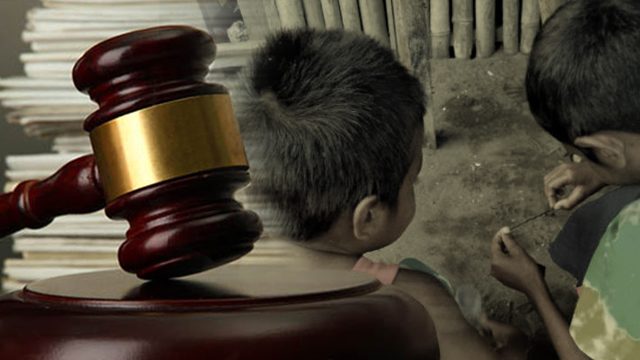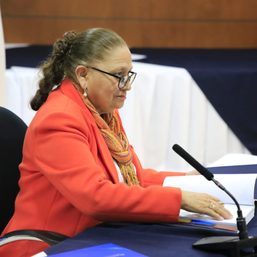SUMMARY
This is AI generated summarization, which may have errors. For context, always refer to the full article.

Part 3
READ: Part 1: Beyond juvenile delinquency: Why children break the law
READ: Part 2: When ‘Houses of Hope’ fail children in conflict with the law
MANILA, Philippines – With poverty and environment as the main enablers of children in conflict with the law (CICL), President Rodrigo Duterte and his allies are pushing for lowering the age of criminal responsibility – from 15 years to 9 years old. But social workers and other organizations say this will not end the proliferation of juvenile crimes.
What then will solve the problem? Social workers and pro-child groups said the cracks in the law have to be addressed first.
Duterte, as early as the 2016 campaign, had sought the amendment of Republic Act 9344 or the Juvenile Justice Act of 2006, which allowed children below 15 years old to get away with their crimes – provided they undergo intervention and rehabilitation.
But what most people do not know is that RA 9344 was already amended in 2013, through RA 10630. Section 20-A of the law allows children as young as 12 years old to be detained for serious crimes such as rape, murder, and homicide, among others. RA 10630 also mandates local government units to manage their own Bahay Pag-Asa (Houses of Hope).
Duterte, echoed by his allies in the House of Representatives, wants to lower the minimum age of criminal liability from 15 years old down to 9. He believes it should be done because syndicates are using more children to commit crimes. (READ: Congressmen want 9-year-old kids charged for crimes)
Run after syndicates, not children
Despite the preference expressed by no less than the President, social workers and pro-child groups do not agree. While they admit there are indeed syndicates using children for crimes, they said the adults should be punished, not the children who are mere victims.
“Oo may ganun talagang scenario, maalam na rin sila. May mga cases sila, kahit wala pang ebidensya na bata ka, once in-allege na bata ka binibigyan ka ng pabor. Pero later hihingi birth certificate, dine-dental aging namin,” Paundog said.
(Yes, there are indeed such scenarios because these people are already knowledgeable. There are cases where even if there’s still no evidence that you’re a kid, once you’re alleged to be a child, they will grant you favors. But later on, they would ask for your certificate and we do dental aging.)
“May mga instances na nagagamit pero kung iko-compare sa bulk ng CICL, di siya significant. Siguro 20%, so babalik pa rin tayo. Kung yun ang problem, di ganun ang solusyon. Ang pinaparusahan mo dun ay yung bata e hindi yung nangbibiktima sa kanila,” she added.
(There are instances children are used but if you compare it to the bulk of CICL, it’s not that significant. Maybe 20% so we would still go back to the problem. If that’s the problem, it’s not the solution. You’re punishing the child there, not the adults who victimize them.)
Rowelyn Acdog, social worker at Yakap-Bata Holding Center in Caloocan shared the same sentiment.
“Ang hahabulin yung matatanda hindi ang bata. Kundi kung sino yung nag-influence, huwag bata ang parusahan,” Acdog said. (We should run after the adults not the children. We should run after those who influence them to do crimes, it shouldn’t be the children who should be punished.)
Most CICLs, according to local social workers and the DSWD, come from poor and dysfunctional families and an unhealthy environment – like Andy*, Carl*, and Bernard*.
Nina Patricia Sison-Arroyo, member of the Council for the Welfare of Children and of the global board of International Justice Mission, said the bill would only discriminate against less fortunate kids – a deeper symptom of a disturbing societal condition in the country. She added that children’s minds are not yet fully developed and are not able to fully discern consequences of their actions. (READ: An open letter to Representatives Alvarez and Castro)
The United Nations Children’s Emergency Fund (Unicef), citing studies, said “adolescents’ brain function reach maturity only at around 16 years old, affecting their reasoning abilities and impulse control.”
If the bill is passed into law, social workers have another issue to deal with – the possibility of mixing younger children with teenagers who have committed more serious crimes. Both Paundog and Acdog said most, if not all, serious crimes are committed by those 12 years old and above. Kids younger than 12 years old, they said, are involved in mostly petty crimes.
“Para sa akin, against talaga ako. Lalo na yan pag maraming na-turn over, kami rin po ang mahihirapan. Saka nakakaawa ihalo sa mga batang may kaso na 15 to 17 years old yung mga 9 years old. Yung batang malalaki at matatanda maa-abuse physically at sexually yung batang maliliit. Marami kaming experience na ganun,” Acdog said.
(For me, I am really against it especially when they turn over many children to us, we’re also the ones who will have a hard time. I also pity those 9 years old and above who will be mixed in detention with those 15 to 17 years old with criminal cases. The older children tend to physically and sexually abuse the younger ones. We’ve seen that many times.)
Proper implementation not amendment
Pro-child groups want the law to be properly implemented instead of amended.
One provision of the law that needs to be effectively enforced is the creation of effective Barangay Councils for the Protection of Children (BCPC).
RA 9344 mandates that LGUs should allot 1% of their internal revenue allotment (IRA) for the BCPCs, which have the power to take preventive steps against juvenile delinquency at the onset through intervention or diversion, which is “an alternative, child-appropriate process of determining the responsibility and treatment of a CICL…without resorting to formal court proceedings.”
Unfortunately, not all BCPCs are effective. Sometimes, those in the barangay are unaware that they could already start diversion procedures at the local level.
In Caloocan, Acdog said BCPCs are not functional. Instead of city social workers focusing on children who committed serious crimes, they are asked to settle petty crimes.
“Kailangan dapat magiging functional ang BCPC. Parang di nila alam yung batas. Refer nang refer lang sa amin. Supposed to be kasama ang barangay sa 5 pillars of justice,” she said.
(The BCPC should be functional. It appears like they don’t know the law. They just keep on referring children to us. Barangays are supposedly included in the 5 pillars of justice.)
“Kung may CICL na-apprehend doon sa barangay, nagu-undergo na dapat sila ng intervention program. Pero ang nangyayari tinu-turn over nila sa amin kahit tsinelas lang ang ninakaw, pinapa-detain sa amin nang ilang araw. Kami ang nag-aayos ng kaso nila or ng settlement kasi ilang araw o weeks dito, eh parang nade-deprive mo na rin ang rights ng bata,” Acdog added.
(If there are CICL apprehended in the barangay, they should go through an intervention program. But what happens is they are turned over to us even if their crime is just stealing slippers. The barangay officials ask us to detain them for a few days. We take care of their cases or settlement because they spend several days or weeks here, and it’s like depriving the kids of their rights.)
Such is the case, too, in Valenzuela. While Valenzuela has more decent and sustainable treatment of CICL, the city also experiences problems with its BCPCs. Even minor offenses such as violations of curfew reach the city social department.
“It all boils down to family. If you will look at the law, it is focused on the commitment of the offense and rehabilitation. But for us who implement it, we see that there is a need to focus on being proactive at the barangay level. The BCPC should be strengthened,” Paundog said in Filipino.
“Because we end up getting congested here because the law is not being implemented in the barangay. Petty cases do not have to reach out. Those children who enter our Bahay Pag-Asa are those qualified by the law. Even petty cases of curfew violation reach us when it should just be in the barangay. If they were only active, the issues would have been settled already at their level. We here could focus on children who need more help,” she added.
No legal procedures for CICL
Another problem is the lack of legal procedures for CICL. There is still a prevalent adult-oriented mentality especially in hearing cases of children. Although CICL’s cases are under the jurisdiction of the family court, the processes are still patterned after adult cases.
Some rules governing CICL, Paundog said, are similar to existing adult-oriented rules.
“I hope there would be a legal procedure especially for children. The dilemma is, we go to court, we prepare for it. We never encourage lying because sooner or later, children are not going to be imprisoned in a regular cell. So we encourage honesty. But when we go to the court, the case is being mixed with regular cases and there is no legal proceeding for children,” Paundog said in Filipino.
While they do not encourage lying, Paundog said public lawyers usually advise CICL not to admit their crimes immediately. This is where the problem lies because a child cannot avail of an intervention program unless he or she admits to committing the crime.
Children who are unable to avail of diversion undergo a normal court process. Once convicted, the crime is recorded. This record, however, should be kept confidential so the child, Paundog said, could still have a chance of leading a normal life.
“If a child is convicted, there is a record but it is concealed. It could not be used against the child. If they get a court clearance, they would still be cleared. That is the good provision in the law, pro-child,” Paundog said.
Shortcuts
Another problem in the implementation of the law is the shortcuts in dealing with CICL.
A CICL aged 15 or below should be placed under the custody of a law enforcement officer, who then looks for the child’s parent or guardian, depending on the severity of the crime.
The officer is mandated to check whether the child will be in danger if he or she returns to his or her parents. If the officer determines that the child is subjected to abuse or abandonment, the child has to go through a diversion or intervention program. These include counseling and education, among others, to improve the child’s psycho-social development.
But Paundog said there are cases where this process is not followed – not just by barangay officers, but also by the police and prosecutors.
“Other than sa barangay, there is such a thing as police diversion. Pag less than 6 years ang penalty, puwede mag-diversion at that level. Pati si prosecutor puwede. Kung gagawin lang sana namin nang tama, masusunod ito (If the penalty is less than 6 years, the police can conduct diversion at that level. Even the prosecutor can do that. If they only do it properly, the law will be followed),” she said.
Paundog said this gap might be due to the lack of information among local officers, even if there are already numerous capacity-building events conducted, lack of interest, or as simple as overloading of social and barangay workers, exacerbate the problem.
“Minsan ang mga stakeholders hindi nagdi-diversion. Minsan di rin nila alam na puwede sila mag-diversion kahit marami nang capability-building na ginagawa. Siguro iwas abala or nakasanayan na, pinapasa na lang lahat sa city social welfare development, sa city hall,” she said.
(Sometimes stakeholders do not conduct diversions. Sometimes they do not know they could do it even if we have already conducted so many capability-building events. Maybe it’s because they don’t want to be bothered, or they’ve gotten used to it – just turning over everything to the city social welfare department, to city hall.)
What now for CICL?
With renewed calls to lower the age of criminal liability supported by no less than the President, it seems unclear if the bill will become law. In the House of Representatives filled with mostly new-found Duterte allies, it will likely happen.
The same could not be said in the Senate. There is no counterpart bill filed so far. But there are senators who are backing the strong position of Duterte against crime and illegal drugs, including the death penalty – which is part of the juvenile justice bill filed in the House.
House Speaker Pantaleon Alvarez is confident Senate President Aquilino Pimentel III, Duterte’s partymate, will support the measure.
While Pimentel has not yet explicitly made known his position, Duterte has found an ally in Majority Leader Vicente Sotto III.
“If they want further amendments to (lower to) 9 years old, payag ako kasi ginagamit ang mga bata (I am for it because children are being used) to commit crimes, especially drug trafficking,” Sotto told Rappler.
Liberal Party senators, however, strongly oppose the measure, with Senator Francis Pangilinan – author of the original RA 9344 – saying that the gravity of the offense, and not the age, should be the main consideration in deciding the penalty.
The Gabriela Women’s Party also opposes the measure, saying it will not address the problem of children involved in crimes. The party said the bill would only scar children and adversely affect their future.
While lawmakers battle it out on the congressional floor, social workers are grappling with the situation made worse by the cracks in the existing juvenile justice laws.
As Duterte and his allies push for the measure, Andy*, Bernard*, and Carl* are serving their sentences in youth homes – some with crowded and unhealthy environments. They remain hopeful that a better future awaits them, even if they will have to return to a difficult life that, to begin with, was what prompted them to break the law. – Rappler.com
*Not their real names to protect their privacy.
Add a comment
How does this make you feel?



![[WATCH] Try This: Empanada Salteña from Argentina](https://www.rappler.com/tachyon/2023/04/try-this-empanada-saltena-argentina.jpg?resize=257%2C257&crop=765px%2C0px%2C1037px%2C1037px)

There are no comments yet. Add your comment to start the conversation.